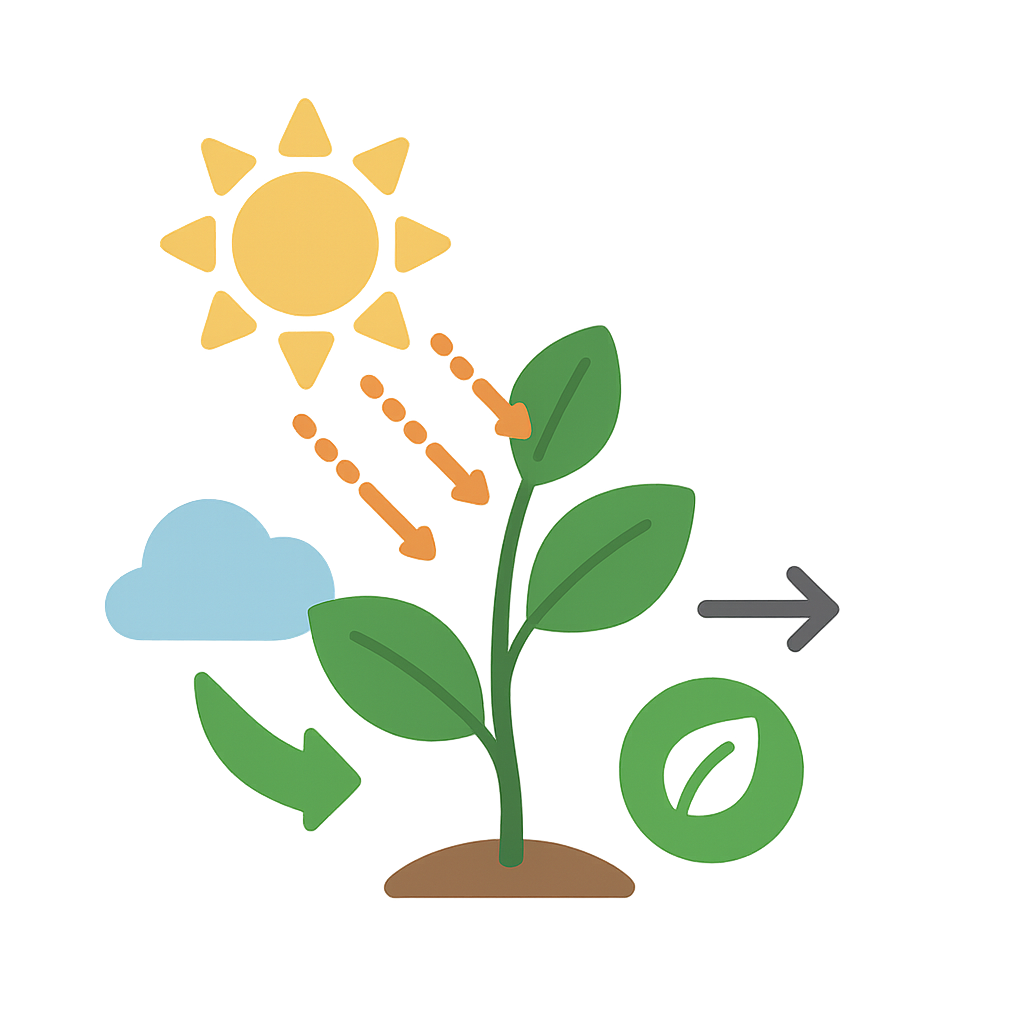The Planet's Secret Chef
Have you ever wondered about the silent magic that happens all around you, every single day? I am that magic. I am the planet’s secret chef, and my kitchen is inside every green leaf, blade of grass, and even in the tiny algae floating in the ocean. I don’t use a stove or an oven. My fire is the golden, brilliant light of the sun, which travels millions of miles just to power my work. My main ingredient is something you give away with every breath you exhale: a gas called carbon dioxide. I take that, and I mix it with cool water that the plants drink up through their roots. I am a master of transformation. Inside the bustling, microscopic world of a plant’s cells, I use the sun’s energy to break apart the water and carbon dioxide molecules and rearrange them. It’s like being the most intricate builder in the universe, using the tiniest possible bricks. My creation is a sweet, energy-packed sugar that becomes the food for the plant to grow tall and strong. But I always make a little extra of something else. As a thank you gift for the ingredients, I release a different gas back into the air, a gas that every animal, including you, needs to live. It’s the very essence of a fresh, clean breeze.
For centuries, I worked in secret. Humans saw my results—towering trees, lush fields, and vibrant flowers—but they had no idea how I did it. They were curious, though. Their brilliant minds started searching for clues to my recipe. One of the first detectives on my case was a man named Jan van Helmont in the 1600s. He planted a small willow tree in a pot of carefully weighed soil. For five years, he gave it nothing but water. The tree grew magnificently, gaining over 160 pounds. But when he weighed the soil again, it had barely lost any weight at all. He was perplexed. “It must be the water,” he concluded. “The tree is made almost entirely of water.” He was on the right track; water is one of my key ingredients. But he had missed a huge part of my story, the part that came from thin air. A century later, another clever man named Joseph Priestley stumbled upon another clue. He was experimenting with sealed glass jars. He discovered that a candle flame would quickly go out in a sealed jar, and a mouse couldn’t survive in it for long. He said the air had become “injured.” But then, he tried something remarkable. He placed a living mint plant inside the jar with the flickering candle. He waited. To his astonishment, after a few days, the candle could be lit again. The mint plant had somehow “restored” the air. He had discovered my gift of oxygen, even if he didn’t know exactly what it was. He saw that I could fix what breathing and burning took away. The final piece of the puzzle was put into place by Jan Ingenhousz. He was fascinated by Priestley’s work and conducted thousands of experiments. He noticed something crucial that everyone else had missed. He saw that my plant friends only performed their air-restoring trick when they were in the sunlight. In the dark, they did nothing. “Aha,” he must have thought, “Light is the catalyst. It’s the energy that makes it all happen.” He was the one who uncovered my secret love for the sun. With all the clues finally assembled—water from van Helmont, air from Priestley, and light from Ingenhousz—humans could finally see my whole recipe. They gave me a name that captures my essence, a Greek word that means “putting together with light.” I am Photosynthesis.
Now that you know my name and my history, you can see that I am your silent partner in life. Every single breath you take is filled with the oxygen I release. I work tirelessly, day in and day out, in every forest, field, and ocean on Earth to keep the air fresh and breathable for you and all other animals. But my role is even bigger than that. The sugary food I create inside plants is the foundation of almost every food chain on the planet. When you eat an apple, you are eating my stored sunshine. When you eat bread made from wheat or a salad made of lettuce, you are borrowing the energy I crafted from light, air, and water. Every animal, from the tiniest insect to the largest whale, depends on my work either directly or indirectly. I also help keep our planet in balance. By using carbon dioxide, the same gas that is warming our climate, I help regulate Earth’s temperature. The more healthy forests and oceans we have, the more of this gas I can pull from the atmosphere. Understanding my process isn’t just a science lesson; it’s the key to protecting our beautiful green world. When you see a tree, don’t just see wood and leaves. See a magical factory, a silent chef, and a guardian of the air. See me, Photosynthesis, your essential partner in the grand, beautiful story of life on Earth.
Reading Comprehension Questions
Click to see answer
